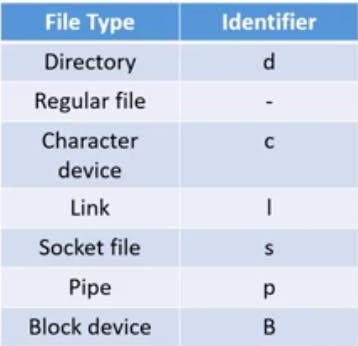Lecture # 20 - File Ownership and Permissions
File Ownership and Permissions in Linux
File Ownership:
Change User Ownership:
To change the user ownership of a file
sudo chown [user-name] [file-name]is used.

Change Group Ownership:
To change group ownership of a file
sudo chown :[group-name] [file-name]is used.

Change User and Group Ownership in one Command:
To change user and group ownership in a single command
sudo chown [user-name]:[group-name] [file-name]is used.
File Permissions:
Permission Categories:
There are three kind of permissions:
Read Permissions (r):
-> For Files: Open and read the files.
-> For Directories: View contents of directories.
Write Permissions (w):
-> For Files: Edit, delete, and save files.
-> For Directories: Modify its contents (create, delete, and rename files inside the directory) and modify the contents of files that has write permissions.
Execute Permissions (x):
-> For Files: Run an executable script.
-> For Directories: Access the directories and details about the files in that directory.
Types of Entities:
Permissions are granted to:
User (u):
Owner of the file or directory.
Group (g):
Group of users to have similar permissions.
Others (o):
Anyone else other than owner and the group.
Permissions Representation:
Permissions are represented with 10 characters.


( - ) shows the file type.

Left most (r w x) is for the Owner User (u).
Middle (r w x) is for the Owner Group (g).
Right most (r w x) is for Others (o)*.*
Important Letters:

Changing Permissions:
Symbolic Mode
We make a combination of letters and operators to set the permissions.
User Permissions:
There are many ways to give permissions:
Give read permission to the user:
sudo chmod u+r [file-name]
Give write permission to the user:
sudo chmod u+w [file-name]
Give execute permission to the user:
sudo chmod u+x [file-name]
Give read and write permissions to the user:
sudo chmod u+rw [file-name]
Give read and execute permissions to the user:
sudo chmod u+rx [file-name]
Give write and execute permissions to the user:
sudo chmod u+wx [file-name]
Give read, write, and execute permissions to the user:
sudo chmod u+rwx [file-name]
Remove read permission from the user:
sudo chmod u-r [file-name]
Remove write permission from the user:
sudo chmod u-w [file-name]
Remove execute permission from the user:
sudo chmod u-x [file-name]
Remove read and write permissions from the user:
sudo chmod u-rw [file-name]
Remove read and execute permissions from the user:
sudo chmod u-rx [file-name]
Remove write and execute permissions from the user:
sudo chmod u-wx [file-name]
Remove read, write, and execute permissions from the user:
sudo chmod u-rwx [file-name]

Group Permissions:
Give read permission to the group:
sudo chmod g+r [file-name]
Give write permission to the group:
sudo chmod g+w [file-name]
Give execute permission to the group:
sudo chmod g+x [file-name]
Give read and write permissions to the group:
sudo chmod g+rw [file-name]
Give read and execute permissions to the group:
sudo chmod g+rx [file-name]
Give write and execute permissions to the group:
sudo chmod g+wx [file-name]
Give read, write, and execute permissions to the group:
sudo chmod g+rwx [file-name]
Remove read permission from the group:
sudo chmod g-r [file-name]
Remove write permission from the group:
sudo chmod g-w [file-name]
Remove execute permission from the group:
sudo chmod g-x [file-name]
Remove read and write permissions from the group:
sudo chmod g-rw [file-name]
Remove read and execute permissions from the group:
sudo chmod g-rx [file-name]
Remove write and execute permissions from the group:
sudo chmod g-wx [file-name]
Remove read, write, and execute permissions from the group:
sudo chmod g-rwx [file-name]

Others Permissions:
Give read permission to others:
sudo chmod o+r [file-name]
Give write permission to others:
sudo chmod o+w [file-name]
Give execute permission to others:
sudo chmod o+x [file-name]
Give read and write permissions to others:
sudo chmod o+rw [file-name]
Give read and execute permissions to others:
sudo chmod o+rx [file-name]
Give write and execute permissions to others:
sudo chmod o+wx [file-name]
Give read, write, and execute permissions to others:
sudo chmod o+rwx [file-name]
Remove read permission from others:
sudo chmod o-r [file-name]
Remove write permission from others:
sudo chmod o-w [file-name]
Remove execute permission from others:
sudo chmod o-x [file-name]
Remove read and write permissions from others:
sudo chmod o-rw [file-name]
Remove read and execute permissions from others:
sudo chmod o-rx [file-name]
Remove write and execute permissions from others:
sudo chmod o-wx [file-name]
Remove read, write, and execute permissions from others:
sudo chmod o-rwx [file-name]
Octal Mode:

We specify the permissions using three digit number. e.g. 764, where 7 is user ownership, 6 is group ownership, and 4 is for others.

777: (rwx) for user, (rwx) for group, (rwx) for others.
sudo chmod 777 [file-name]
000: (---) for user, (---) for group, (---) for others.
sudo chmod 000 [file-name]
763: (rwx) for user, (rw-) for group, (-wx) for others,
sudo chmod 763 [file-name]
542: (r-x) for user, (r--) for group, (-w-) for others,
sudo chmod 542 [file-name]
There are multiple combinations for the octal mode. e.g. 765, 111, 124, 521, etc.
